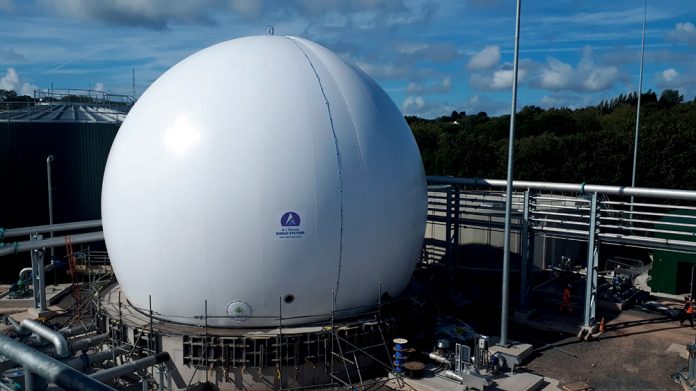A technically advanced, membrane-based, and inexpensive solution to the storage of biogas.
A wastewater treatment works is essentially a factory. This factory has an input of what we do not want, and do not even speak about much – our waste – and an output of three by-products: clean water, fertilizer, and electricity. Clean water back to the environment, treated organically rich solids back to farming, and abundant electricity from generators driven by engines burning biogas.
The UK’s wastewater industry has harnessed the biogas produced from the biodegradation of sewage for more than 100 years, and gas from a septic tank was first used to run a gas lamp in Exeter as long ago as 1895. We have come a long way since then.
A J Tensile Biogas Systems Limited is an industry leader in the manufacturer of membrane gas storage vessels and digester roofs. It is part of the A J Tensile Group that designs, fabricates and installs any membrane structure, but the Biogas division is dedicated to the design and production of biogas systems. The company has much background knowledge on the ‘whys and wherefores’ of AD, and as such understands exactly why biogas storage is so important, and, uniquely, the company will actually advise biogas storage solutions that are simpler and therefore cheaper than are sometimes asked for by clients. Possibly not uniquely commercial, that view! But it is part of what we do.
To store biogas when production from the digester or use by the ‘users’ varies during a period, a storage vessel is obviously required. Traditionally, these vessels were a little like traditional town gas holders: large steel tanks with fixed or rising roofs. But steel, although apparently of high strength and long life, is attacked by the chemicals in biogas, and one in particular: hydrogen sulphide. This, in the presence of water, gives rise to sulphuric acid, which corrodes the steel rapidly unless it is expensive high-grade stainless steel. So, back in the 1980s, the concept of using membrane technology for these storage vessels was developed. Membrane structures are recognisable everywhere: canopies, sports halls – even the O2 Arena. The membranes are of great strength and resilience and will withstand all weather and most chemical-attack conditions.
There are two types of membrane gasholder storage solutions in normal use on a sewage works: a stand-alone gas holder, and a membrane roof covering an anaerobic digester. Both are designed with an exterior, completely weather-resistant outer membrane, and a biogas-holding inner membrane. The membranes can be of amazing strength. The strongest we normally use is such that a 1m wide strip of fabric just over 1mm thick is capable of lifting 20 tonnes, but there are even stronger materials that we occasionally use. The material is basically a pvc-coated polyester yarn, with the many woven strands forming an immensely strong material.
A recent example, above left, of a stand-alone membrane gasholder is a 2,000m3 capacity gasholder installed for Skanska at the end of August this year on their Welsh Water Cog Moors plant. It is installed on a raised plinth, so that all the associated pipework, condensate removal, etc., is easily accessible by the operator. With its permanently operating inflation fans to create the weather-resistant outer structure, and its associated gas contents measurement and safety instruments, the unit is a self-contained item that requires little maintenance beyond a biennial inspection. Accurate laser level-sensing gives the operator an exact knowledge of the amount of gas in the inner membrane, and this allows accurate manipulation of downstream equipment such as surplus gas burners and biogas-burning CHP engines, which drive the generators.
The world of biogas handling moves on. When motorists driving along a motorway see what they might think is a Fylingdales-type Early Warning System structure, it is probably an A J Tensile Biogas Systems gasholder!
www.ajtensile.co.uk




